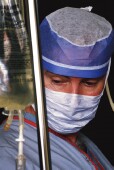
WEDNESDAY, Jan. 22, 2014 (HealthDay News) — Drug-coated “scaffolds” that are placed in the arteries and then melt away over time could offer a new treatment for people with painfully clogged leg arteries, an early study suggests.
Researchers found that the experimental devices eased leg pain in 35 patients with peripheral artery disease. People with the condition have artery-clogging “plaques” impeding blood flow to the legs. Before treatment, 57 percent of the patients had severe pain when they walked; one month after treatment, none of them did.
The findings, scheduled for presentation Wednesday at the International Symposium on Endovascular Therapy, in Miami, should be considered preliminary until published in a peer-reviewed medical journal.
And experts cautioned that it’s not clear how these devices compare with the current treatment for more severe cases of peripheral artery disease — namely, traditional metal stents.
The new devices are similar to stents, according to background information included in the study. In both cases, the implants are threaded into a blocked artery through a catheter. Once there, they prop open the vessel and slowly release medication designed to reduce inflammation and prevent the artery from narrowing again.
But unlike stents, which remain in the artery, the scaffolds eventually disappear, the researchers said. They’re made of polylactide, a biodegradable material that’s already used in dissolving sutures.
The idea is to leave behind a normally functioning blood vessel and avoid some of the long-term complications that can arise with stents, said Dr. Johannes Lammer, the lead researcher on the study.
One problem with stents is that they can irritate and inflame the artery lining, causing the vessel to narrow again — a condition doctors call “restenosis.” Also, Lammer said, stents in leg arteries can break because leg arteries, unlike heart arteries, are under significant pressure from everyday movements.
Additionally, if a patient eventually needs bypass surgery to restore better blood flow to the legs, stents can interfere with the procedure, Lammer said.
Dr. Angel Caldera, an interventional cardiologist at Scott & White Memorial Hospital in Round Rock, Texas, said it’s best if there is no device in the arteries.
Caldera, who was not involved in the study, agreed that the dissolving scaffolds have potentially important advantages. But they remain to be proven, he stressed.
“This study is a feasibility and safety trial,” Caldera said. “All we can say is, ‘Yes, we can do this, and it appears to be safe.’ Is this going to be better than what we have now? It’s way too early to tell.”
Still, Caldera called the preliminary findings “encouraging,” and said it’s “exciting” to see new technology being developed for treatment of peripheral artery disease.
Abbott Laboratories, which funded the study, already has a similar scaffold device approved in Europe and parts of Asia and Latin America for treating blocked heart arteries. Trials aimed at approval in the United States are under way.
For the current study, Lammer and his colleagues at the Medical University of Vienna, in Austria, implanted the devices in 35 patients with a single blockage in a leg artery.
Before the procedure, 57 percent of the patients had severe leg pain when they walked, according to the researchers. Over the next six months, that dropped to zero. The percentage with moderate pain dipped from 34 percent to 9 percent.
By month six, two-thirds of the patients were pain-free, and the rest had only mild symptoms.
Both Lammer and Caldera said plenty of questions remain. The current study will follow the patients for three years to see how they fare in the long term.
Lammer said a trial that compares the dissolving scaffolds with standard stents is still needed. A big question is whether the newer devices really do curb the risk of restenosis, he said.
Dr. Alex Powell is medical director of interventional radiology at Baptist Cardiac and Vascular Institute in Miami. He said: “Long-term data is necessary before labeling a procedure a success. Walking will always be the most important component of [peripheral artery disease] therapy. No medication or procedure will ever take away the benefits of a walking program.”
For now, stents seem to help many people with more severe peripheral artery disease. In another study on the agenda at the endovascular meeting, researchers followed 250 stent patients for three years. At that point, 73 percent of treated arteries were still open and, on average, the patients were still walking farther and faster than they had before treatment.
Peripheral artery disease affects an estimated 8 million people in the United States. The same health problems that contribute to heart disease can also feed peripheral artery disease, including diabetes, smoking, high blood pressure and high cholesterol.
Often, Caldera said, peripheral artery disease can be managed by reining in those risk factors and getting moderate exercise. Stents and bypass surgery are reserved for more severe cases.
“What’s most important,” Caldera said, “is smoking cessation and controlling diabetes, high cholesterol and high blood pressure so you never get to the point of needing stents.”
More information
The American Heart Association has more on peripheral artery disease.
Copyright © 2025 HealthDay. All rights reserved.

